Mazda CX-30 v Kia Seltos v Renault Kadjar: Best compact SUV revealed
Australians love their SUVs. And now a new class of affordable small family SUVs have arrived, but which is the best one for you?

car advice
Don't miss out on the headlines from car advice. Followed categories will be added to My News.
Television tells us life is hard for middle children. Lisa (Simpson), Jan (Brady) and Malcolm (in the middle) have lives of quiet desperation while siblings steal the attention of their parents and the viewing public.

But that won’t be the case for a new breed of compact SUVs.
Recognising the endless tide of buyers switching from regular cars to high-riding crossovers, makers are bringing in new models that sit between city versions and more family-friendly versions.
Mazda CX-30
Aimed at the sizeable gap between the tiny Mazda CX-3 and surprisingly large CX-5, the CX-30 is the textbook example of the new-breed SUVs.
Essentially a reworked Mazda3, the CX-30 shares engines, interior layout and core underpinnings with the small hatch.
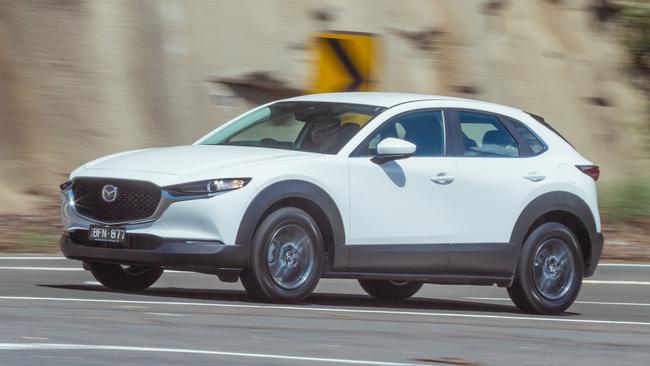
We tested the CX-30 in G20 Pure entry grade. Priced from $29,990 plus on-roads (about $34,000 drive-away), the CX-30 also matches the Mazda3 with a good degree of standard kit.
Driver aids such as active cruise control, blind spot monitoring, lane keeping assistance and autonomous emergency braking (front and rear) are part of the deal. There is assurance from the five-year, unlimited kilometre warranty though capped servicing, affordable at $1635 for five years, is dulled by short 10,000km intervals.

As in the Mazda3, the 8.8-inch infotainment screen is tucked near the base of the windscreen. In the SUV, it’s not touch-sensitive, so access to key functions is via a rotary dial near the gear selector. It divides opinion — we like it but there are more intuitive solutions, particularly when using smartphone mirroring such as Apple CarPlay.
Driver ergonomics are outstanding, though offset by the rear seat’s head and legroom, which are cosier than rivals. The Mazda also has the smallest boot here by some margin — 317L against 408L in the Renault and 433L in the Kia.
A willing little engine, the Mazda’s 2.0-litre (114kW/200Nm) is reasonably economical (about 6.5L/100km) but noisy when delivering its best.

Mazda wins points for the best gearbox here, a slick six-speed automatic with clever software. Sweet steering suggests the CX-30 and MX-5 development teams trade notes and noise suppression is toward the top of this class.
The wooden brake pedal, loud suspension action and less-than-tenacious tyres take the edge off its performance. The donor hatch feels planted on the road but the high-riding CX-30 needs an extra moment to settle after mid-corner bumps.
Renault Kadjar
The Kadjar, like the Mazda, slots in tidily between stablemates, the compact Clio-based Captur and the bigger Koleos, the latter built by Samsung in South Korea as an adaptation of Nissan’s X-Trail. A European-built spin on the Nissan Qashqai, the Kadjar has more space and a better engine.
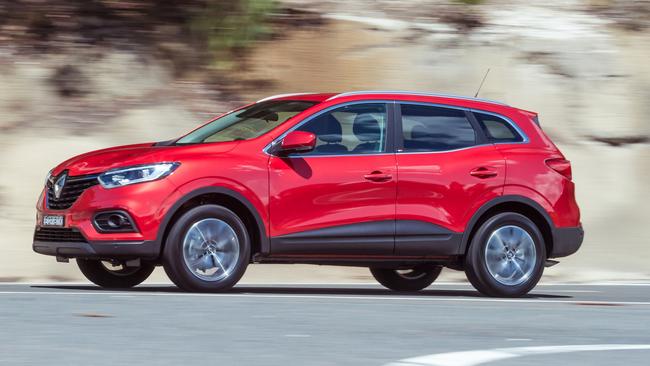
We asked Renault for an entry-level Kadjar Life (from $31,490 drive-away) but had to settle for a mid-range Kadjar Zen, which is $35,490 drive-away.
The Zen shares running gear with the base car, adding such niceties as premium interior trim, smart keys and safety features including blind spot and lane departure alerts.
Drive-away deals for the Kadjar include three years of free servicing, enhanced by generous 30,000km service intervals.
As the biggest car here, the Kadjar is more spacious than the Seltos or CX-30. It wins family points with rear USB ports and air vents, centre armrest and cupholders you won’t find in cheaper rivals.

Its digital driver’s display is excellent but its main infotainment screen — the smallest here at seven inches — hosts Apple CarPlay/Android Auto but not digital radio.
The stereo looks cheap but there’s a touch of Audi or Range Rover in the clever digital displays within climate control dials. The absence of a physical volume knob is frustrating but the block of radio controls tucked behind the steering wheel, once mastered, proves genius.
Renault hasn’t submitted the Kadjar for ANCAP crash testing. Against the Mazda, the Kadjar can’t compete on safety kit or class-leading occupant protection.
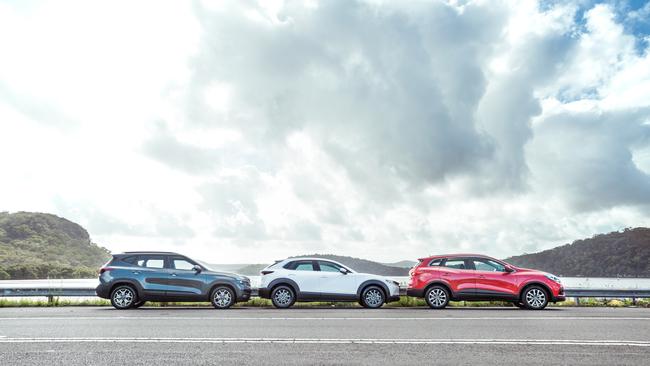
It’s engine, however, is the pick. The Mercedes-built 1.3-litre four-cylinder turbo (117kW/260Nm) uses 6.3L/100km, doing so with less effort than naturally aspirated rivals.
It’s a shame the Kadjar’s seven-speed dual-clutch automatic proves doughy and hesitant in this company.
Middle of the road for refinement, the Kadjar combines super-light steering with compliant suspension that feels more composed than the Mazda.
Kia Seltos
For now, the Seltos is the baby in Kia’s SUV range. The tiny Stonic crossover joins it, and the bigger Sportage and Sorento, in the second half of the year.
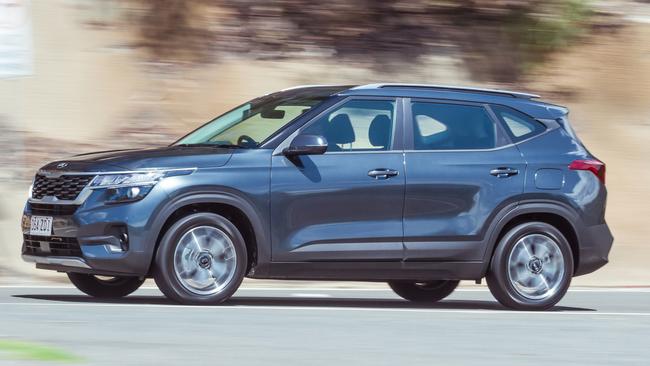
Tested in Sport trim with a $1000 safety pack, the Seltos is $30,490 drive-away — a sharp figure when you factor in its class-leading seven-year warranty.
It doesn’t quite match the Mazda’s safety credentials (such as reverse emergency braking) but it is the value pick of the bunch.
Standard equipment includes a massive 10.25-inch wide-screen touch display with satnav, reversing camera and Apple CarPlay/Android Auto. It’s an impressive set-up but the 3.5-inch digital driver display is a little basic.
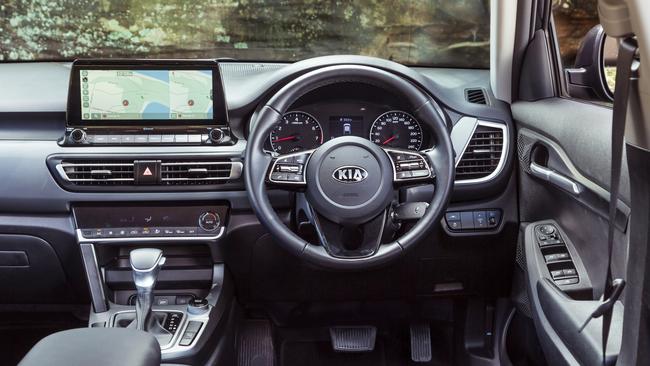
The Seltos also misses out on smart keys at this price but you can address that by spending more on high-grade variants with extra kit. It pulls off an impressive double — the biggest boot of the bunch and the sole full-size spare.
Space in the front and rear is more than adequate. It’s roomier than the Mazda, thanks in part to a boxy silhouette that looks a little plain in the car park.
Cheaper Seltos grades come with a thirsty and underwhelming engine, which uses the most fuel (6.8L/100km) to make the least power (110kW/180Nm) of this lot.
Factor in the heftiest kerb weight and you’ll soon discover the Seltos is no dragster.
It excels in the bends, however, hooking into corners with minimal body roll and responding well to the oddly weighted steering.

It shrugs off bumps effortlessly, maintaining its composure on country highways thanks to suspension tuned for local road conditions.
But it’s not all rosy. Its continuously variable transmission can be slow to react, underscoring the engine’s weakness and on the motorway it is easily the loudest of the trio for wind and road noise.
Verdict
The Renault’s space and sweet motor are strong points and the Mazda’s style and safety impress. The Kia is the pick — tough to beat for value, the Seltos has the strongest warranty and is the most practical thanks to its spacious cabin, huge boot and full-size spare.
Mazda CX-30 G20 Pure vitals
Price: About $34,000 drive-away
Warranty/servicing: 5 years/unlimited km, $1635 for 5 years
Safety: 5 stars, 6 airbags, AEB, blind spot monitoring, active cruise control, lane keep assist
Engine: 2.0-litre 4-cyl, 114kW/200Nm
Thirst: 6.5L/100km
Boot: 317L
Renault Kadjar Zen vitals
Price: $35,490 drive-away
Warranty/servicing: 5 years/unlimited km, $1178 for 5 years
Safety: Not rated, 6 airbags, AEB, blind spot monitoring, lane departure warning
Engine: 1.3-litre 4-cyl turbo, 117kW/260Nm
Thirst: 6.3L/100km
Boot: 408L
Kia Seltos Sport with Safety pack vitals
Price: $30,490 drive-away
Warranty/servicing: 7 years/unlimited km, $1914 for 5 years
Safety: 5 stars, 6 airbags, AEB, active cruise control, driver attention monitor
Engine: 2.0-litre 4-cyl, 110kW/180Nm
Thirst: 6.8L/100km
Boot: 433L
Originally published as Mazda CX-30 v Kia Seltos v Renault Kadjar: Best compact SUV revealed


